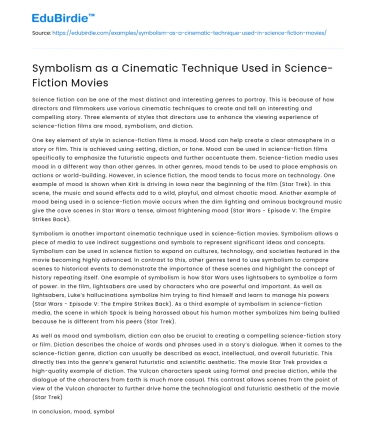Science fiction can be one of the most distinct and interesting genres to portray. This is because of how directors and filmmakers use various cinematic techniques to create and tell an interesting and compelling story. Three elements of styles that directors use to enhance the viewing experience of science-fiction films are mood, symbolism, and diction.
One key element of style in science-fiction films is mood. Mood can help create a clear atmosphere in a story or film. This is achieved using setting, diction, or tone. Mood can be used in science-fiction films specifically to emphasize the futuristic aspects and further accentuate them. Science-fiction media uses mood in a different way than other genres. In other genres, mood tends to be used to place emphasis on actions or world-building. However, in science fiction, the mood tends to focus more on technology. One example of mood is shown when Kirk is driving in Iowa near the beginning of the film (Star Trek). In this scene, the music and sound effects add to a wild, playful, and almost chaotic mood. Another example of mood being used in a science-fiction movie occurs when the dim lighting and ominous background music give the cave scenes in Star Wars a tense, almost frightening mood (Star Wars - Episode V: The Empire Strikes Back).
Save your time!
We can take care of your essay
- Proper editing and formatting
- Free revision, title page, and bibliography
- Flexible prices and money-back guarantee
Symbolism is another important cinematic technique used in science-fiction movies. Symbolism allows a piece of media to use indirect suggestions and symbols to represent significant ideas and concepts. Symbolism can be used in science fiction to expand on cultures, technology, and societies featured in the movie becoming highly advanced. In contrast to this, other genres tend to use symbolism to compare scenes to historical events to demonstrate the importance of these scenes and highlight the concept of history repeating itself. One example of symbolism is how Star Wars uses lightsabers to symbolize a form of power. In the film, lightsabers are used by characters who are powerful and important. As well as lightsabers, Luke’s hallucinations symbolize him trying to find himself and learn to manage his powers (Star Wars - Episode V: The Empire Strikes Back). As a third example of symbolism in science-fiction media, the scene in which Spock is being harassed about his human mother symbolizes him being bullied because he is different from his peers (Star Trek).
As well as mood and symbolism, diction can also be crucial to creating a compelling science-fiction story or film. Diction describes the choice of words and phrases used in a story’s dialogue. When it comes to the science-fiction genre, diction can usually be described as exact, intellectual, and overall futuristic. This directly ties into the genre’s general futuristic and scientific aesthetic. The movie Star Trek provides a high-quality example of diction. The Vulcan characters speak using formal and precise diction, while the dialogue of the characters from Earth is much more casual. This contrast allows scenes from the point of view of the Vulcan character to further drive home the technological and futuristic aesthetic of the movie (Star Trek)
In conclusion, mood, symbolism, and diction are some of the most important cinematic techniques to keep in mind when creating science-fiction films. Using these elements can greatly improve media of the science-fiction genre. Along with this, paying attention to elements of style such as the aforementioned three can enable the viewer to further appreciate what comes into a compelling science-fiction film and overall increase society’s appreciation for the genre.






 Stuck on your essay?
Stuck on your essay?

